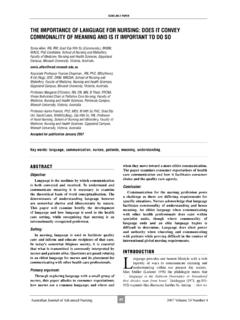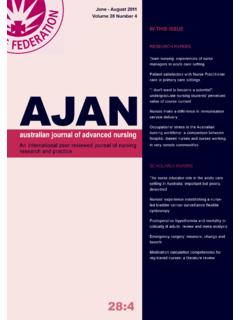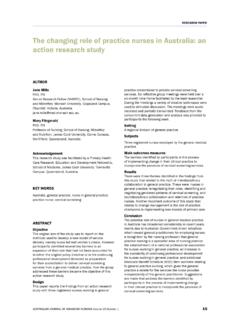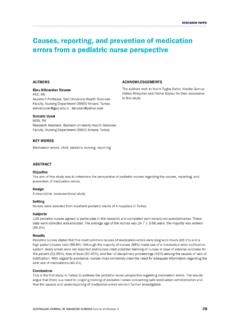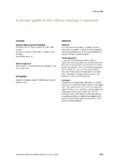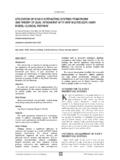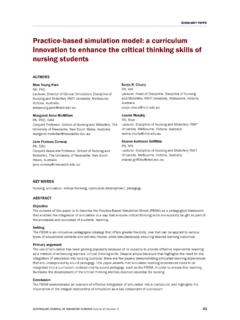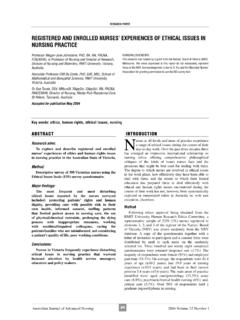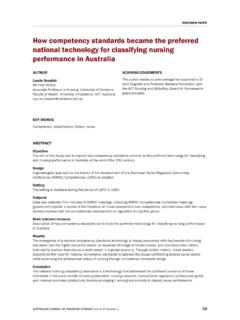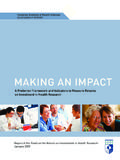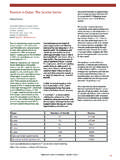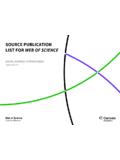Transcription of MENTORING: IMPROVING TRANSITION TO PRACTICE
1 SCHOLARLY PAPER. MENTORING: IMPROVING TRANSITION TO PRACTICE . Karen Theobald, PhD, RN, BAppSC, GCertHigherEd, MHScNurs, SEDA, MRCNA, is a Lecturer in Nursing, Queensland University of Technology, Australia Marion Mitchell, RN, RM, CHN, BN(Hons), GCertHigherEd, MRCNA, is a Associate Lecturer in Nursing, Griffith University, Australia Accepted for publication February 2002. Key words: mentoring, clinical PRACTICE , nursing students, graduate TRANSITION ABSTRACT INTRODUC TION. T. Nurse graduates indicate the TRANSITION from he role of a RN in today's health care facilities is student of nursing to registered nurse (RN) is a difficult complex and demanding. Students of nursing conversion. This impending change of role and undertake university study to prepare both accompanying higher expectations placed upon newly theoretically and practically to undertake this role. graduating RNs causes concern for students as their Although students have a structured university program Bachelor of Nursing program nears completion.
2 A which supports their development to fulfil the expectations career mentor scheme is suggested as a way to better of the workplace, consistently, finishing students voice prepare final year students for this TRANSITION . their feelings of being underprepared for their impending Evaluations indicate the positive impact the scheme change in status. has made on both mentors and mentees as it has A nursing mentor scheme is suggested as a way to enhanced their career development. promote assimilation of final year students of nursing into the complex arena of health care. This paper discusses the Queensland University of Technology's (QUT), Australia, nursing mentor program in relation to similarly named overseas programs. In the QUT nursing mentor program, final year students of nursing, are allocated for a period of one university year to an RN, who volunteers his/her time to be involved in the nursing mentor program.
3 Within the students' university program, they already have 10 weeks where they attend prescribed, assessed, clinical PRACTICE for five days a week (four weeks in semester one and six weeks in semester two). This clinical practicum is considerable and has evolved in response to feedback from both graduating students and employers who considered graduating students were underprepared for their role as beginning level RNs. Despite the increased clinical hours within the final year, students continue to describe feeling inadequate about their preparation for TRANSITION to PRACTICE . In response to students' feedback, the QUT. School of Nursing in 1992, became part of the inaugural university wide, Career Mentor Scheme program. Other participating disciplines included geology and journalism. The QUT mentee is defined as a final year student who voluntarily, seeks additional professional guidance from an experienced RN.
4 This model defines mentoring as: a developmental, caring, sharing, and helping relationship where one person invests time, know-how and effort in enhancing another person's growth, knowledge and skills ' (Shea 1994, ). It also includes professional nurturing and guiding the novitate'. Australian journal of Advanced Nursing 27 2002 Volume 20 Number 1. SCHOLARLY PAPER. (Butterworth 1992, ) with the experienced practitioner comments that cost effectiveness means cuts in the providing sponsorship, guidance, education and nursing workforce. This situation has inevitable personal assistance' (Bidwell and Brasler 1989, ) to a consequences for student experience and for beginning novice. graduate responsibilities' ( ). One may speculate that graduates experience reduced support during cost cutting This RN or mentor, acts as a guide, professional exercises, which is potentially detrimental to their colleague, tutor, supporter or informal counsellor.
5 The development and the subsequent care of clients. QUT mentorship program does not involve any component of student assessment and this is thought to be One strategy to assist beginning level practitioners to a particular strength over schemes outside Australia. prepare for the complex health care context is the use of Rather, the scheme promotes the development of a mentoring partnerships. The suggested QUT model professional and sometimes personal relationship between accrues a limited financial burden to the university and the individuals intent on IMPROVING the mentee's TRANSITION to health care facility involved, as the mentors volunteer for PRACTICE . no financial gain. The university accepts responsibility for the organisation of the program and nurse academics QUT has indemnity insurance cover which is already in organise the program as part of their academic role with existence for students' clinical practicums, and this cover administrative support from the university-wide mentor has been extended to include the Career Mentor Scheme scheme coordinator.
6 Program. The indemnity insurance ensures legal issues are examined and facilitates flexibility of activities within the Currently, the program is organised toward the end of mentorship relationship. This paper suggests that social the second year of the Bachelor of Nursing program when learning theories' explain the theoretical underpinnings of students are informed about the program and invited to the learning processes that occur within the QUT nursing register an expression of interest in becoming a mentee. mentor program. The benefits, limitations and Subsequently, early within the student's final year, a mentor/mentee responses to the QUT program are also second invitation is given to formally participate in the discussed. scheme. Students are required to complete a registration form containing demographic details, their clinical areas of interest and the goals they hope to achieve within the SETTING THE SCENE program.
7 In addition, students need to submit a brief Historically, nurse education programs were based curriculum vitae. Prior to the commencement of the upon the concepts of formal apprenticeships. Apprentices mentorship program, all students are expected to attend a (trainee nurses) were under the tight control of a master briefing session where an overview of the aims and practitioner (the ward sister) whilst engaged in labour of objectives of the scheme are discussed again with low skill and knowledge complexity requiring minimal particular reference to the strategies which they may wish specialisation (Maggs 1983). Recent changes in the social to utilise with their mentor. All students who complete climate coupled with rapid advancement in medical these requirements are included within the program and a technology and practices have radically altered the nature mentor is provided for them. of nursing today.
8 Current nursing PRACTICE reflects Mentoring in nursing is not a new concept. Florence sophisticated specialised nursing knowledge and skill in a Nightingale, used a mentor style program to promote the collaborative patient care environment, thereby placing concepts and philosophies that she espoused (Tucker- increasing burdens of accountability on nursing staff. A Allen et al 1992; Steele and Baker 1992). The partnerships substantial change in PRACTICE has also occurred with that Nightingale encouraged between qualified nurses and changes to the education system to university-based trainees were based on caring, sharing, support programs which see nursing students entering complex relationships (Tucker-Allen et al 1992) to enhance nursing PRACTICE environments as students rather than workers. PRACTICE . Such relationships can be equated to the Consequently, students' clinical experience is reduced and mentorship programs of today.
9 These programs are used to the emphasis during this time has an educational focus promote the positive TRANSITION for nursing graduates into rather than being task orientated. clinical PRACTICE settings (Bidwell and Brasler 1989). TRANSITION to PRACTICE includes socialisation into the work Students' limited periods of time within clinical place (Dorsey 1992), acquisition of psychomotor nursing PRACTICE settings reduces their ability to develop skills (Butterworth 1992; Hart and Rotem 1994), and proficiency as clinicians (Theobald, Nancarrow and promotion of effective communication (Woodrow 1994). McCowan 1999). However, upon graduation they are expected to assume the role of RN with full responsibility Socialisation into the norms and practices of nursing, for the care of a group of clients. Many institutions provide and the feeling of acceptance by nurses in general (Goran beginning RNs with a period where they work alongside 2001; Spouse 1998), is integral to the development of new an experienced nurse (preceptorship), however, this option graduates within the workplace (Stevens and Crouch is at the discretion of the facility and is not afforded to all 1998).
10 Moreover, Woodrow (1994) suggests that graduates. Clare (1991) writes of the situation for new mentoring offers students of nursing the opportunity to graduates in New Zealand in the early 1990s and develop into caring professionals through direct Australian journal of Advanced Nursing 28 2002 Volume 20 Number 1. SCHOLARLY PAPER. involvement with clinical PRACTICE in partnership with achieve this, the mentorship program utilises current one's mentor, thereby reducing the theory PRACTICE gap. practising RNs as mentors to support final year students. Each student's registration form indicates areas of nursing Authors from the United Kingdom (UK) (Foy and interest and preferences and it is with this information that Waltho 1989; Lee 1989; Woodrow 1994; Neary 2000;. mentor and mentee are allocated. For example, a student Neary, Phillips and Davis 1996) suggest that the indicating an interest in a future career in the operating mentor/mentee relationship should occur with a student or room, will be allocated where possible, with a new graduate being paired with a more experienced nurse perioperative nurse.
